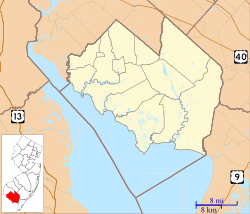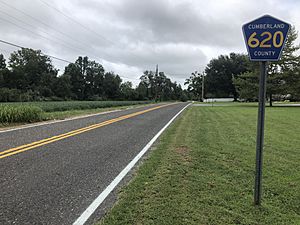Greenwich Township, Cumberland County, New Jersey facts for kids
Greenwich Township is a small community located in Cumberland County, New Jersey, in the U.S. state of New Jersey. It's the westernmost township in Cumberland County. In 2020, about 771 people lived here. It's a quiet place that's part of the larger Vineland-Bridgeton area.
Quick facts for kids
Greenwich Township, New Jersey
|
||
|---|---|---|
|
Township
|
||
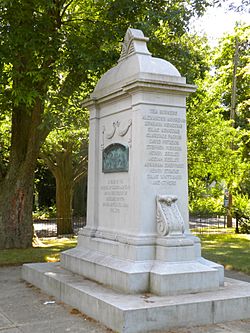
Teaburners' Monument
|
||
|
||
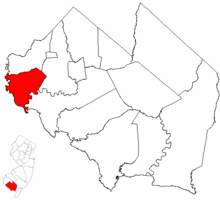
Location of Greenwich Township in Cumberland County highlighted in red (right). Inset map: Location of Cumberland County in New Jersey highlighted in red (left).
|
||
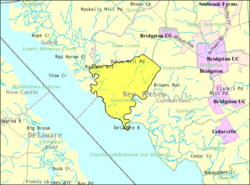
Census Bureau map of Greenwich Township, Cumberland County, New Jersey
|
||
| Country | ||
| State | ||
| County | Cumberland | |
| Established | January 19, 1748 | |
| Incorporated | February 21, 1798 | |
| Named for | Greenwich, England | |
| Government | ||
| • Type | Township | |
| • Body | Township Committee | |
| Area | ||
| • Total | 18.75 sq mi (48.55 km2) | |
| • Land | 17.77 sq mi (46.03 km2) | |
| • Water | 0.97 sq mi (2.52 km2) 5.19% | |
| Area rank | 152nd of 565 in state 11th of 14 in county |
|
| Elevation | 20 ft (6 m) | |
| Population
(2020)
|
||
| • Total | 771 | |
| • Estimate
(2023)
|
763 | |
| • Rank | 544th of 565 in state 13th of 14 in county |
|
| • Density | 43.4/sq mi (16.8/km2) | |
| • Density rank | 555th of 565 in state 13th of 14 in county |
|
| Time zone | UTC−05:00 (Eastern (EST)) | |
| • Summer (DST) | UTC−04:00 (Eastern (EDT)) | |
| ZIP Code |
08323
|
|
| Area code(s) | 856 exchanges: 451, 453, 455 | |
| FIPS code | 3401128170 | |
| GNIS feature ID | 0882058 | |
| Website | ||
Contents
A Look at Greenwich Township's Past
Greenwich Township was first set up as a "precinct" on January 19, 1748. A precinct is like an early version of a local area. Later, on February 21, 1798, it officially became one of New Jersey's first 104 townships. A township is a type of local government area. The township was named after Greenwich, England.
The Greenwich Tea Party
A very important event happened here in 1774, just before the American Revolutionary War. A ship carrying tea was supposed to send its cargo to Philadelphia, Pennsylvania. But instead, a group of local people burned the tea at night. This event is known as the Greenwich Tea Party. It was a protest against British taxes, similar to the more famous Boston Tea Party. After the Revolutionary War, people in Greenwich Township started saying "Green-witch" instead of "Gren-itch" to sound different from the English town.
Where is Greenwich Township?
Greenwich Township covers about 18.75 square miles (48.55 square kilometers). Most of this area is land, with a small part being water.
The township shares its borders with several other towns. These include Fairfield Township, Hopewell Township, and Stow Creek Township in Cumberland County. It also borders Lower Alloways Creek Township in Salem County and the Delaware Bay.
Some smaller communities and places within Greenwich Township are Bacons Neck, Bayside, Caviar, Davis Mills, Greenwich, Othello, Sheppards Mill, Springtown, and Stathams Neck.
People Living in Greenwich Township
| Historical population | |||
|---|---|---|---|
| Census | Pop. | %± | |
| 1810 | 858 | — | |
| 1820 | 890 | 3.7% | |
| 1830 | 912 | 2.5% | |
| 1840 | 918 | 0.7% | |
| 1850 | 1,158 | 26.1% | |
| 1860 | 1,265 | 9.2% | |
| 1870 | 1,262 | −0.2% | |
| 1880 | 1,245 | −1.3% | |
| 1890 | 1,173 | −5.8% | |
| 1900 | 1,283 | 9.4% | |
| 1910 | 1,145 | −10.8% | |
| 1920 | 966 | −15.6% | |
| 1930 | 979 | 1.3% | |
| 1940 | 929 | −5.1% | |
| 1950 | 966 | 4.0% | |
| 1960 | 1,086 | 12.4% | |
| 1970 | 963 | −11.3% | |
| 1980 | 973 | 1.0% | |
| 1990 | 911 | −6.4% | |
| 2000 | 847 | −7.0% | |
| 2010 | 804 | −5.1% | |
| 2020 | 771 | −4.1% | |
| 2023 (est.) | 763 | −5.1% | |
| Population sources: 1810–2010 1810–1920 1840 1850–1870 1850 1870 1880–1890 1890–1910 1910–1930 1940–2000 2000 2010 2020 |
|||
In 2010, there were 804 people living in Greenwich Township. Most of the people (about 91%) were White. About 4% were Black or African American, and about 1% were Native American. A small number of people were Asian or from other backgrounds. About 3% of the population identified as Hispanic or Latino.
The average age of people in the township was about 47.7 years old. About 20% of the population was under 18, and 18% was 65 or older.
Education in Greenwich Township
Students in Greenwich Township attend schools through the Greenwich Township School District.
Elementary and Middle School
Younger students, from kindergarten through eighth grade, go to Morris Goodwin School. This school is part of a partnership with the Stow Creek School District. This means that students from both Greenwich and Stow Creek townships attend Morris Goodwin School for grades K-4. Then, for grades 5-8, students from both townships go to Stow Creek School.
High School
For high school, students in ninth through twelfth grades attend Cumberland Regional High School. This high school also serves students from several other nearby townships and boroughs. The high school has a board of education that helps make decisions, and Greenwich Township has one seat on this board.
Students who want to learn a specific trade or skill can also attend the Cumberland County Technical Education Center in Vineland. This center offers special training programs for students from all over Cumberland County.
Getting Around Greenwich Township
As of 2010, Greenwich Township had about 33 miles of roads. Some of these roads are maintained by the township itself, while others are maintained by Cumberland County.
There are no major highways like Interstates or U.S. routes that go through Greenwich Township. The roads here are mostly smaller county roads, such as County Route 620.
Famous People from Greenwich Township
Many interesting people have connections to Greenwich Township:
- Philip Vickers Fithian (1747–1776) was a tutor who wrote journals and letters about his experiences.
- Robert Patterson (1743–1824) was an educator and also directed the United States Mint.
- Roland Renne (1905–1989) was a professor who became the President of Montana State College.
- George Bacon Wood (1797–1879) was a doctor, professor, and writer.
See also
 In Spanish: Municipio de Greenwich (condado de Cumberland) para niños
In Spanish: Municipio de Greenwich (condado de Cumberland) para niños



